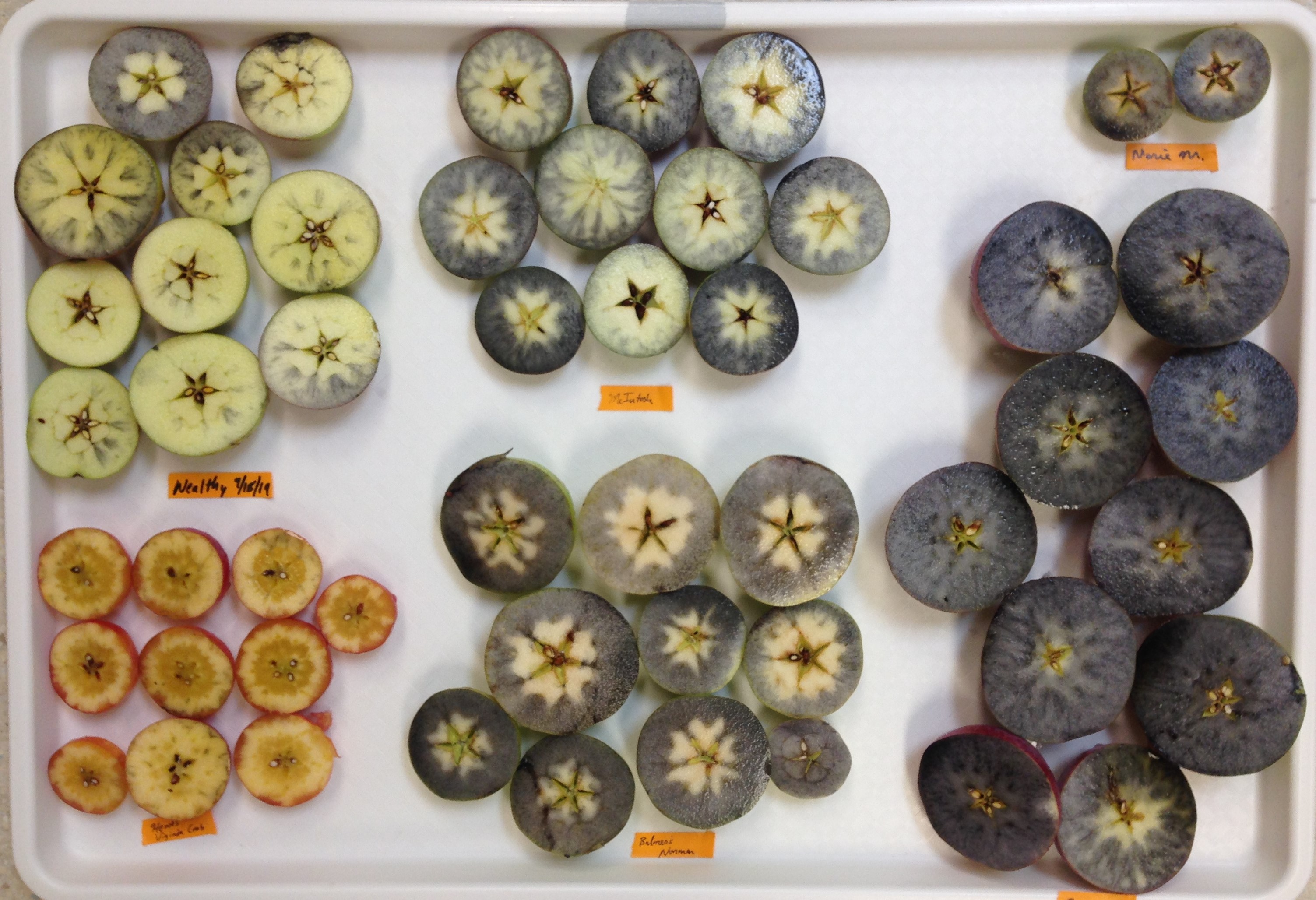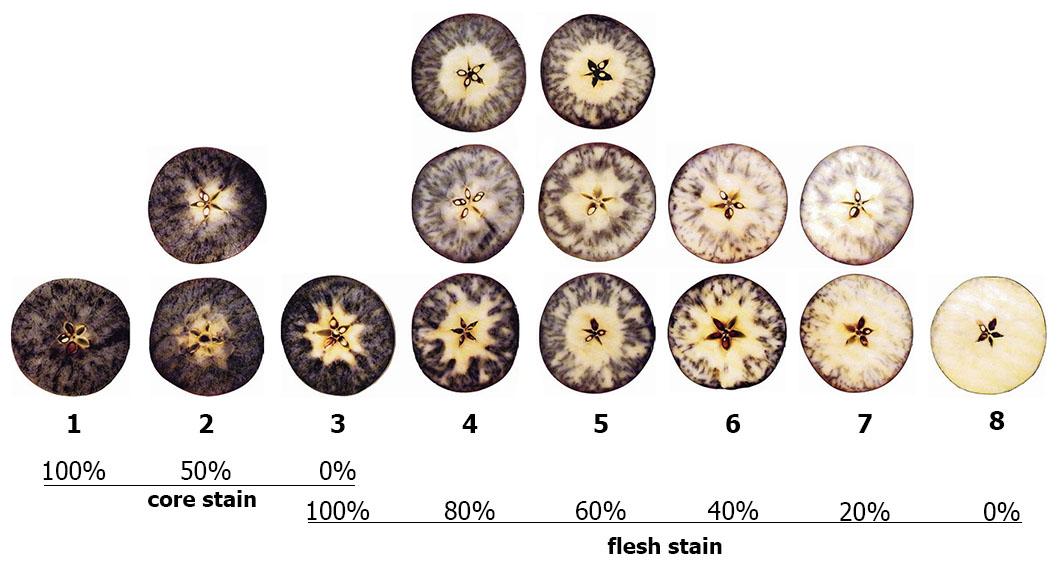Apple cultivar maturity at WARC - Fall 2019
Updated 10/09/19
The starch-iodine index is a method to assess apple maturity (ripeness). Fruit can either be sprayed or dipped in an iodine solution. After two minutes, fruit can be visually compared to rating scales to rank their maturity.
Test principles. As apples ripen, starch is converted to sugars. The iodine in the test solution binds to starch in the fruit: the more purple-black stain on a fruit, the less mature or ripe the fruit is.
Visual rating scales. Several rating scales exist. We are using the Cornell Starch-Iodine Index [1], which ranks fruit 1-8, with 1 being less ripe, and 8 being fully ripe. A 1-6 scale is popular with Washington growers, and due to unique starch patterns, a separate scale for 'Honeycrisp' has been developed [2].
Utility. For dessert apple cultivars, picking fruit at optimal maturity for either fresh eating or for storage is an important part of marketing fruit. For cider apples, research suggests cultivar has more impact than ripeness on volatile profiles (aroma) of resulting ciders in one study [3], and phenolics were not greatly impacted by apple maturity (ripeness) in another [4]. In Montana, hard cider varieties tend to be picked at more advanced maturity or what would be considered overripe for dessert varieties.
How to obtain the iodine solution. Pre-mixed iodine solution can be purchased through Wilson Irrigation in Yakima, WA. Virginia Cooperative Extension also has recipes for making the solution detailed in Harvest Maturity Resources [5].
Other tools for assessing fruit ripeness. Brix (a measure of sugars), firmness, and other tools can also be used to assess fruit maturity and quality. See Apple Maturity and Harvest [6] by Washington State University for further details.
Starch-Iodine Index of apples varieties at WARC, fall 2019.
Averages are of 10 fruit picked to represent both interior and exterior canopy fruit and the planting as a whole, unless otherwise noted.
| Cultivar - Harvest Date | Date of measurement of starch-iodine index | |||||
|
|
8/27/19 |
09/03/19 |
09/10/19 |
09/18/19 |
09/25/19 |
10/08/19* |
|
'Bulmers Norman' (cider) - 10/03/19 |
2 |
|
2 |
2.6 |
|
|
|
'Cortland' - Codling moth experiment harvested 10/02/19 |
1 |
1 |
1.1 |
1.2 |
2 |
4.6 |
|
'Crimson Passion' |
|
|
2 (three interior canopy fruit) |
|
4.7 |
|
|
'Hewes Virginia Crab' (cider) - 9/18/19 |
|
4 |
5.2 |
7.7 |
|
|
|
'McIntosh' (combination 100-year old orchard + tree by the gate) - Most harvested 10/04/19 |
|
|
2.4 |
4.6 |
6.6 |
|
|
'Wealthy' (one 100-year old tree) - Harvested over weekend 10/05/19 |
|
|
7.3 (three fruit) |
6.3 |
6.2 |
|
|
'Zestar' - 9/11/19 |
5.3 (three fruit) |
8 (five interior canopy fruit) |
||||
*10/09/19: There is snow on the ground and we've had four nights since 9/30 where temperatures dipped below 28 F. We consider apple harvest at WARC complete.
Starch-Iodine test at WARC 09/18/19

References
- Blanpied, G.D. and K.J. Silsby, Predicting harvest date windows for apples, Information Bulletin 221. 1992, Cornell Cooperative Extension Publication: Cornell University. p. 1-12. Available from: https://ecommons.cornell.edu/bitstream/handle/1813/3299/Predicting%20Harvest%20Date%20Window%20for%20Apples.pdf;jsessionid=AA54A3E7FD1F8262EA372ECF34AF9A52?sequence=2 (Accessed Sept. 11, 2019)
- Hanrahan, I. Starch Iodine Index Honeycrisp. 2012. Washington Tree Fruit Research Commission website]. Available from: Starch Iodine Index Honeycrisp(Accessed Sept. 11, 2019)
- Rosend, J., et al., The effects of apple variety, ripening stage, and yeast strain on the volatile composition of apple cider. Heliyon, 2019. 5(6): p. e01953-e01953.
- Ewing, B., et al., Management of Apple Maturity and Postharvest Storage Conditions to Increase Polyphenols in Cider. HortScience, 2019. 54: p. 143-148.
- Peck, G. Harvest Maturity Resources. 2012. Available from: https://blogs.ext.vt.edu/tree-fruit-horticulture/2012/08/23/harvest-maturity-resources/. (Accessed Sept. 11, 2019)
- WSU Tree Fruit Comprehensive Tree Fruit Site, Washington State University. Apple Maturity and Harvest. 2017. Available from: http://treefruit.wsu.edu/web-article/harvest-apples/. (Accessed Sept. 11, 2019)

